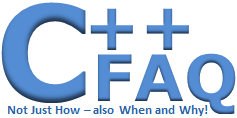FAQ: How exactly do I read/write simple types in non-human-readable ("binary") format? ←(in the new Super-FAQ)
It's in Section: Serialization and Unserialization:
- FAQ: What's this "serialization" thing all about?
- FAQ: How do I select the best serialization technique?
- FAQ: How do I decide whether to serialize to human-readable ("text") or non-human-readable ("binary") format?
- FAQ: How do I serialize/unserialize simple types like numbers, characters, strings, etc.?
- FAQ: How exactly do I read/write simple types in human-readable ("text") format?
- FAQ: How exactly do I read/write simple types in non-human-readable ("binary") format? (this FAQ)
- FAQ: How do I serialize objects that aren't part of an inheritance hierarchy and that don't contain pointers to other objects?
- FAQ: How do I serialize objects that are part of an inheritance hierarchy and that don't contain pointers to other objects?
- FAQ: How do I serialize objects that contain pointers to other objects, but those pointers form a tree with no cycles and no joins?
- FAQ: How do I serialize objects that contain pointers to other objects, but those pointers form a tree with no cycles and only "trivial" joins?
- FAQ: How do I serialize objects that contain pointers to other objects, and those pointers form a graph that might have cycles or non-trivial joins?
- FAQ: Are there any caveats when serializing / unserializing objects?
- FAQ: What's all this about graphs, trees, nodes, cycles, joins, and joins at the leaves vs. internal nodes?
